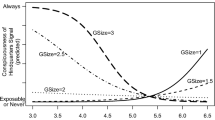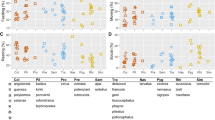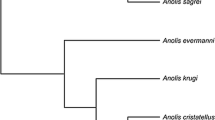Abstract
Countershading is defined as an animal displaying a dark dorsal and light ventral surface. This color pattern is found in numerous species, yet there are relatively few quantitative tests that examine its potential adaptive nature. The most frequently employed explanation for countershading is its ability to increase crypsis. I used a comparative approach to test 2 predictions of this hypothesis in primates. First, diurnal species should exhibit stronger countershading versus nocturnal species because light levels are low at night, reducing the benefit of countershading. Second, the degree of countershading should decrease as body mass increases because large animals should have a lower predation risk. I collected data from 171 museum specimens representing 63 primate species. Using digital photography, I quantified the average luminance values on the ventral and dorsal surfaces of each specimen and defined the degree of countershading as the ratio of these values. Nocturnal primates displayed similar levels of countershading compared to diurnal species. Previous studies have shown that some nocturnal primates are more active when moonlight levels are high, suggesting that countershaded pelages may act as an antipredator adaptation. I also found support for a negative relationship between body mass and the degree of countershading using both species values and phylogenetically independent contrasts. There were some exceptions to this pattern, including low levels of countershading for most callitrichine species, which may be due to the vertical positional behavior of many callitrichines, thereby reducing any benefit gained from countershading. In sum, variation in primate countershading is related to body mass and phylogeny, but not to activity pattern.


Similar content being viewed by others
References
Allman, J. (1977). Evolution of the visual system in early primates. In J. M. Sprague & A. N. Epstein (Eds.), Progress in psychobiology and physiological psychology, Vol. 7 (pp. 1–53).
Anderson, P. J. B., Rogers, Q. R., & Morris, J. G. (2002). Cats require more dietary phenylalanine or tyrosine for melanin deposition in hair than for maximal growth. Journal of Nutrition, 132, 2037–2042.
Bearder, S. K., Nekaris, K. A. I., & Curtis, D. J. (2006). A re-evaluation of the role of vision in the activity and communication of nocturnal primates. Folia Primatologica, 77, 50–71.
Behrens, R. R. (2009). Revisiting Abbott Thayer: Non-scientific reflections about camouflage in art, war and zoology. Philosophical Transactions of the Royal Society B, 364, 497–501.
Bininda-Emonds, O. R. P., Cardillo, M., Jones, K. E., MacPhee, R. D. E., Beck, R. M. D., Grenyer, R., et al. (2007). The delayed rise of present-day mammals. Nature, 446, 507–512.
Bortolotti, G. R. (2006). Natural selection and avian coloration: Protection, concealment, advertisement or deception? In G. E. Hill & K. J. McGraw (Eds.), Bird coloration: Volume 2: Function and evolution (pp. 3–35). Cambridge, MA: Harvard University Press.
Bradley, B. J., & Mundy, N. I. (2008). The primate palette: The evolution of primate coloration. Evolutionary Anthropology, 17, 97–111.
Burtt, E. H. (1981). The adaptiveness of colors. BioScience, 31, 723–729.
Campbell, C., Fuentes, A., MacKinnon, K., Panger, M., & Bearder, S. (eds). (2007). Primates in perspective. Oxford: Oxford University Press.
Cardillo, M., Mace, G. M., Gittleman, J. L., Jones, K. E., Bielby, J., & Purvis, A. (2008). The predictability of extinction: Biological and external correlates of decline in mammals. Proceedings of the Royal Society B-Biological Sciences, 275, 1441–1448.
Caro, T. (2005). The adaptive significance of coloration in mammals. BioScience, 55, 125–136.
Chapman, C. A. (1986). Boa constrictor predation and group response in white-faced cebus monkeys. Biotropica, 18, 171–172.
Cheney, D. L., & Wrangham, R. W. (1987). Predation. In B. Smuts, D. L. Cheney, R. M. Seyfarth, R. W. Wrangham & T. T. Struhsaker (Eds.), Primate societies (pp. 227–239). Chicago: University of Chicago Press.
Cowlishaw, G. (1997). Refuge use and predation risk in a desert baboon population. Animal Behaviour, 54, 241–253.
Demes, B., Jungers, W. L., Fleagle, J. G., Wunderlich, R., Richmond, B. G., & Lemelin, P. (1996). Body size and leaping kinematics in Malagasy vertical clingers and leapers. Journal of Human Evolution, 31, 367–388.
Fay, J. M., Carroll, R., Kerbis Peterhans, J. C., & Harris, D. (1995). Leopard attack on and consumption of gorillas in the Central African Republic. Journal of Human Evolution, 29, 93–99.
Felsenstein, J. (1985). Phylogenies and the comparative method. American Naturalist, 125, 1–15.
Fleagle, J. G. (1999). Primate adaptation and evolution. San Diego: Academic Press.
Garber, P. A. (1992). Vertical clinging, small body size, and the evolution of feeding adaptations in the Callitrichinae. American Journal of Physical Anthropology, 88, 469–482.
Garland, T., Jr., Harvey, P. H., & Ives, A. R. (1992). Procedures for the analysis of comparative data using phylogenetically independent contrasts. Systematic Biology, 41(1), 18–32.
Gursky, S. (2002). The behavioral ecology of the spectral tarsier, Tarsius spectrum. Evolutionary Anthropology, 11, 226–234.
Hamilton, W. J. (1973). Life’s colour code. London: McGraw-Hill.
Harvey, P. H., & Pagel, M. D. (1991). The comparative method in evolutionary biology. New York: Oxford University Press.
Hershkovitz, P. (1968). Metachromism or the principle of evolutionary change in mammalian tegumentary colors. Evolution, 22, 556–575.
Hershkovitz, P. (1977). Living new world monkeys (Platyrrhini) (Vol. 1). Chicago: University of Chicago Press.
Jacobs, S. C., Larson, A., & Cheverud, J. M. (1995). Phylogenetic relationships and orthogenetic evolution of coat color among tamarins (genus Saguinus). Systematic Biology, 44, 515–532.
Janson, C. H. (1992). Evolutionary ecology of primate social structure. In E. A. Smith & B. Winterhalder (Eds.), Evolutionary ecology and human behavior (pp. 95–130). New York: Aldine de Gruyter.
Jarman, P. J. (1974). The social organisation of antelope in relation to their ecology. Behaviour, 48, 215–266.
Kamilar, J. M., & Paciulli, L. M. (2008). Examining the extinction risk of specialized folivores: A comparative study of colobine monkeys. American Journal of Primatology, 70, 816–827.
Karpanty, S. M. (2003). Behavioral and ecological interactions of raptors and lemurs in southeastern Madagascar: A multiple predator approach. DAI, 65, 287.
Kiltie, R. A. (1988). Countershading—universally deceptive or deceptively universal. Trends in Ecology and Evolution, 3, 21–23.
Kiltie, R. A. (1989). Testing Thayer’s countershading hypothesis—an image-processing approach. Animal Behaviour, 38, 542–544.
Maddison, W. P., & Maddison, D. R. (2007). Mesquite: A modular system for evolutionary analysis. Version 2.0. http://mesquiteproject.org.
McGraw, K. J. (2006). The mechanics of melanin-based coloration. In G. E. Hill & K. J. McGraw (Eds.), Bird coloration. I. Mechanisms and measurements (pp. 243–294). Cambridge, MA: Harvard University Press.
Midford, P. E., Garland, T., & Maddison, W. P. (2007). PDAP: PDTREE package for Mesquite, version 1.1. http://mesquiteproject.org/pdap_mesquite/
Miller, L. E., & Treves, A. (2007). Predation on primates: Past studies, current challenges, and direction for the future. In C. J. Campbell, A. Fuentes, K. C. MacKinnon, M. Panger & S. K. Bearder (Eds.), Primates in perspective (pp. 525–543). New York: Oxford University Press.
Mittermeier, R. A., Konstant, W. R., Hawkins, F., Louis, E. E., Langrand, O., Ratsimbazafy, J., et al. (2006). Lemurs of Madagscar. Washington, DC: Conservation International.
Nash, L. T. (2007). Moonlight and behavior in nocturnal and cathemeral primates, especially Lepilemur leucopus: Illuminating possible anti-predator efforts. In S. L. Gursky & K. A. I. Nekaris (Eds.), Primate anti-predator strategies (pp. 173–205). New York: Springer.
Nunn, C. L., & Barton, R. A. (2001). Comparative methods for studying primate adaptation and allometry. Evolutionary Anthropology, 10, 81–98.
Ossi, K. M., & Kamilar, J. M. (2006). Environmental and phylogenetic correlates of Eulemur behavior and ecology (Primates: Lemuridae). Behavioral Ecology and Sociobiology, 61, 53–64.
Purvis, A., Gittleman, J. L., Cowlishaw, G., & Mace, G. M. (2000). Predicting extinction risk in declining species. Proceedings of the Royal Society of London Series B-Biological Sciences, 267, 1947–1952.
Quinn, G., & Keough, M. (2002). Experimental design and data analysis for biologists. Cambridge, UK: Cambridge University Press.
Ross, C. F. (2000). Into the light: The origin of Anthropoidea. Annual Reviews of Anthropology, 29, 147–194.
Rowland, H. M. (2009). From Abbott Thayer to the present day: What have we learned about the function of countershading? Philosophical Transactions of the Royal Society B, 364, 519–527.
Rowland, H. M., Cuthill, I. C., Harvey, I. F., Speed, M., & Ruxton, G. D. (2008). Can’t tell the caterpillars from the trees: Countershading enhances survival in a woodland. Proceedings of the Royal Society B-Biological Sciences, 275, 2539–2546.
Ruxton, G. D., Speed, M., & Kelly, D. J. (2004). What, if anything, is the adaptive function of countershading? Animal Behaviour, 68, 445–451.
Smith, R. J., & Jungers, W. L. (1997). Body mass in comparative primatology. Journal of Human Evolution, 32, 523–559.
Stanford, C. B. (2002). Avoiding predators: Expectations and evidence in primate antipredator behavior. International Journal of Primatology, 23, 741–757.
Stoner, C. J., Bininda-Emonds, O. R. P., & Caro, T. (2003a). The adaptive significance of coloration in lagomorphs. Biological Journal of the Linnaean Society, 79, 309–328.
Stoner, C. J., Caro, T. M., & Graham, C. M. (2003b). Ecological and behavioral correlates of coloration in artiodactyls: Systematic analyses of conventional hypotheses. Behavioral Ecology, 14, 823–840.
Terborgh, J. (1983). Five new world primates: A study in comparative ecology. Princeton: Princeton University Press.
Thayer, A. H. (1896). The law which underlie protective coloration. Auk, 13, 124–129.
Thayer, G. H. (1909). Concealing-colouration in the animal kingdom and exposition of the laws of disguise through colour and pattern: being a summary of Abbot H. Thayer’s discoveries. New York: Macmillan.
van Schaik, C. P. (1983). Why are diurnal primates living in groups? Behaviour, 8, 120–143.
van Schaik, C. P., & van Hooff, J. (1983). On the ultimate causes of primate social systems. Behavior, 85, 91–117.
Walker, S. E. (1996). The evolution of positional behavior in the saki-uakaris (Pithecia, Chiropotes, and Cacajao). In M. A. Norconk, A. L. Rosenberger & P. A. Garber (Eds.), Adaptive radiation of Neotropical primates (pp. 335–367). New York: Plenum Press.
Wrangham, R. W., & Cheney, D. L. (1985). Predation rates and social structure in primates. American Journal of Primatology, 8, 372–372.
Yu, S., Rogers, Q. R., & Morris, J. G. (2001). Effect of low levels of dietary tyrosine on the hair colour of cats. Journal of Small Animal Practice, 42, 176–180.
Zuberbuhler, K., & Jenny, D. (2002). Leopard predation and primate evolution. Journal of Human Evolution, 43, 873–886.
Acknowledgments
I thank Eileen Westwig at the American Museum of Natural History and Bill Stanley at the Field Museum for access to the primate collections and logistical support. Amy Pokempner, Wendy Erb, Kerry Ossi, Lisa Paciulli, Sara Martin, James Higham, Joanna Setchell, and 2 anonymous reviewers offered helpful comments on earlier versions of this manuscript. Melissa Gerald and Brenda Bradley provided stimulating discussions regarding primate coloration and methods for collecting color data. I thank James Higham for inviting me to contribute to this special issue. This research was supported by grants from the Field Museum, Washington University in St. Louis, and the Leakey Foundation.
Author information
Authors and Affiliations
Corresponding author
Rights and permissions
About this article
Cite this article
Kamilar, J.M. Interspecific Variation in Primate Countershading: Effects of Activity Pattern, Body Mass, and Phylogeny. Int J Primatol 30, 877–891 (2009). https://doi.org/10.1007/s10764-009-9359-9
Received:
Accepted:
Published:
Issue Date:
DOI: https://doi.org/10.1007/s10764-009-9359-9




